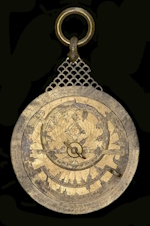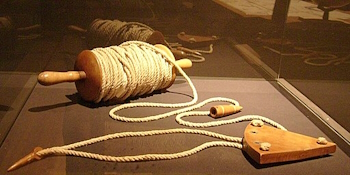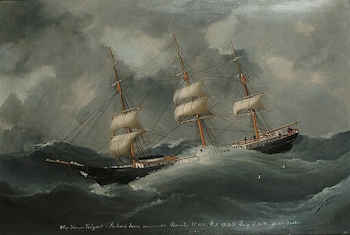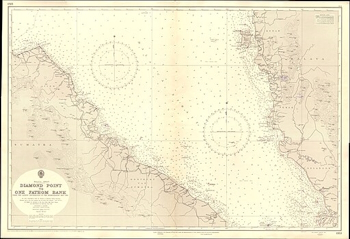Astrolabe
 This device is thought to have been first developed by the ancient Greeks, the term astrolabe meaning ‘star taker.’ It is a primitive inclinometer that calculates the altitude of the sun and stars to determine latitude. An astrolabe can be used for both astronomy and navigation at sea. Elaborate astrolabes can have etchings of how the sky looks at any given time or season. Sailors used this device by lining it up with the sun or a specific star, such as the North Star, in relation to the horizon in order to measure latitude vertically. This helped sailors to determine their location while at sea. Astrolabes came in a variety of shapes, such as a sphere or as flat plates and disks, and were made of metal, usually brass or iron, the former ensuring longevity at sea. A disadvantage was that astrolabes were cumbersome and could be difficult to use on the rolling deck of a ship.…
This device is thought to have been first developed by the ancient Greeks, the term astrolabe meaning ‘star taker.’ It is a primitive inclinometer that calculates the altitude of the sun and stars to determine latitude. An astrolabe can be used for both astronomy and navigation at sea. Elaborate astrolabes can have etchings of how the sky looks at any given time or season. Sailors used this device by lining it up with the sun or a specific star, such as the North Star, in relation to the horizon in order to measure latitude vertically. This helped sailors to determine their location while at sea. Astrolabes came in a variety of shapes, such as a sphere or as flat plates and disks, and were made of metal, usually brass or iron, the former ensuring longevity at sea. A disadvantage was that astrolabes were cumbersome and could be difficult to use on the rolling deck of a ship.…

 In the Age of Sail, sailors measured the speed of their vessel by tying knots at intervals (every 47’3”) in a rope, called a log-line, which was attached to a wooden board called a chip log, also known as a common log, ship’s log, or just log. The board was dropped over the stern of the ship and the number of knots that passed in thirty seconds while the rope unwound were counted. The wooden board and line were attached to a reel and weighted on one edge to float perpendicularly to the water surface, offering substantial resistance to the water moving around it. The knots were tied on the line at a distance of 47 feet 3 inches (14.4018 m). They passed through a sailor’s fingers, while another sailor used a 30-second sand-glass to time the operation. The knot count would be reported and used for navigation. 1 knot equals 1 nautical mile or 1.151 land miles per hour.…
In the Age of Sail, sailors measured the speed of their vessel by tying knots at intervals (every 47’3”) in a rope, called a log-line, which was attached to a wooden board called a chip log, also known as a common log, ship’s log, or just log. The board was dropped over the stern of the ship and the number of knots that passed in thirty seconds while the rope unwound were counted. The wooden board and line were attached to a reel and weighted on one edge to float perpendicularly to the water surface, offering substantial resistance to the water moving around it. The knots were tied on the line at a distance of 47 feet 3 inches (14.4018 m). They passed through a sailor’s fingers, while another sailor used a 30-second sand-glass to time the operation. The knot count would be reported and used for navigation. 1 knot equals 1 nautical mile or 1.151 land miles per hour.… In the past, the wind speed was usually reported in knots until the Beaufort scale was developed in 1806 by the Royal Navy officer Francis Beaufort. The Lighthouse builder, John Smeaton, proposed in 1759 that the wind speed should be correlated with simple verbal descriptions, but this never caught on. A knot is equal to 1 nautical mile per hour, which is approximately 1.15 land miles or 1.85 kilometres an hour.
In the past, the wind speed was usually reported in knots until the Beaufort scale was developed in 1806 by the Royal Navy officer Francis Beaufort. The Lighthouse builder, John Smeaton, proposed in 1759 that the wind speed should be correlated with simple verbal descriptions, but this never caught on. A knot is equal to 1 nautical mile per hour, which is approximately 1.15 land miles or 1.85 kilometres an hour. A fathom is a nautical unit of measurement equal to 6 feet (1.8288 m), historically used for measuring the depth of water. The word derives, via the Middle English word fathme, from the Old English word fæðm, which is cognate with the Danish word favn, meaning a ‘pair of outstretched arms’. A burial at sea officially requires a minimum of six fathoms of water, probably being the origin of the phrase ‘to deep six’ as meaning to discard, or dispose of something. The phrase is echoed in Shakespeare’s The Tempest, where Ariel tells Ferdinand, ‘Full fathom five thy father lies’, which means his body is lost deep at sea.
A fathom is a nautical unit of measurement equal to 6 feet (1.8288 m), historically used for measuring the depth of water. The word derives, via the Middle English word fathme, from the Old English word fæðm, which is cognate with the Danish word favn, meaning a ‘pair of outstretched arms’. A burial at sea officially requires a minimum of six fathoms of water, probably being the origin of the phrase ‘to deep six’ as meaning to discard, or dispose of something. The phrase is echoed in Shakespeare’s The Tempest, where Ariel tells Ferdinand, ‘Full fathom five thy father lies’, which means his body is lost deep at sea.